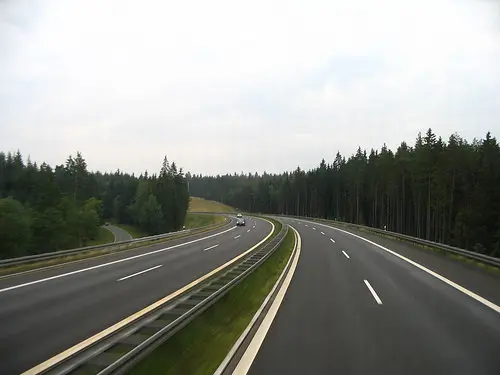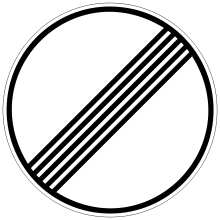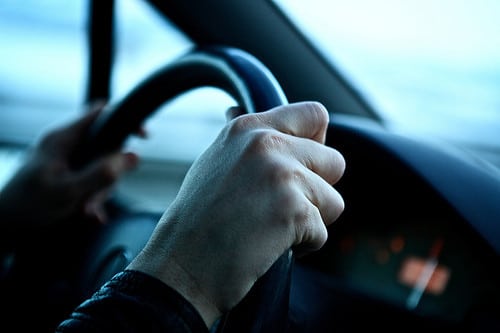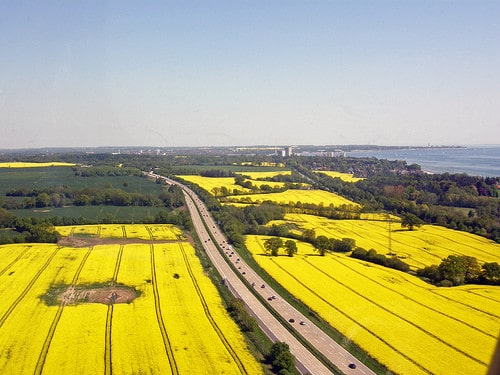Driving on the German freeway, better known as the autobahn, is an experience onto itself. While it is a practical way to get around Germany (even though the country has an excellent public rail system) it’s just fun to drive on. Contrary to what most people may think, the autobahn is an organized road that isn’t a lawless, dangerous, completely unlimited speed limit zone.

Some Ground Rules
For starters, the German autobahn has speed limits. Sections of the road have speed limits based on their proximity to exits and towns – when you get further away from these areas the speed limit restrictions are lifted. The sign that indicates this is gray, with 5 diagonal lines you can see in the picture right, and lets you know you can go as fast as traffic (or your car) allows.
 That means you can really go as fast as you want and better be careful to get out of the way if someone wants to pass. On the German autobahn passing on the right is forbidden and people take these rules seriously. Cars from behind don’t slow down as the approach someone ahead if that person can move to the right. In many cases, if you don’t move over to the left you’re libel to get into a car accident.
That means you can really go as fast as you want and better be careful to get out of the way if someone wants to pass. On the German autobahn passing on the right is forbidden and people take these rules seriously. Cars from behind don’t slow down as the approach someone ahead if that person can move to the right. In many cases, if you don’t move over to the left you’re libel to get into a car accident.- Stopping is also not allowed on the autobahn and you should use your emergency blinkers to let others know traffic ahead is slowing down.
Despite the fact that there are no speed limits in sections of the autobahn, most people don’t drive as fast as they can. Most cars manufactured in Europe have smaller engines than you’ll find in the US, the official recommended autobahn speed is 130 kph (~80mph) and driving close to top speed burns fuel very quickly in a place where a liter is around $2.
Who’s Can Drive On The Autobahn Legally?
European Union citizens, and American citizens from [36 of the 50] states can drive with their license from home in Germany for up to one year. Technically you’re supposed to have a translation of the license with you but for basic traffic violations most police won’t scrutinize a license too thoroughly.

Go With The Flow
In many parts of the US, if you use your high beams to flash someone ahead of you they might simply slow down just to be a pain. On the German autobahn, this is a perfectly acceptable way to let someone going slower in front of you know you’re coming up and to get over. Cars don’t stick around in the left lane if there are others driving faster, like I mentioned above, it’s a good way to cause a major accident.
- That also means if someone flashes you, don’t take it personally, just move over and let the faster car go.
You should also use your signal blinkers whenever you change lanes, especially in speed limit free zones.
Scanned and Straight
 Sections of the autobahn without speed restrictions are generally very straight with few slight curves and bends. To maintain their resilience, the roads are scanned up and down using a series of devices that look for any breaks, cracks, and debris in the roadway. Crews also drive up and down the road continuously and quickly close down lanes to remove any hazards.
Sections of the autobahn without speed restrictions are generally very straight with few slight curves and bends. To maintain their resilience, the roads are scanned up and down using a series of devices that look for any breaks, cracks, and debris in the roadway. Crews also drive up and down the road continuously and quickly close down lanes to remove any hazards.
- The Germans also don’t simply patch up cracks and potholes; they just replace the entire section of roadway when needed.
Don’t fear laying on the gas, the road won’t suddenly shift left or right and changes in the speed limit will indicate places where it’s safer to drive slower.
Give It A Shot
The German autobahn was created in the early 1910s and greatly expanded during the 30s to give unimpeded, fast access between different parts of the country.
- Between some cities it can actually be cheaper (and often easier) to rent a car and pay for a tank of gas rather than take the train.
- There are no tolls along the autobahn for cars.
It’s fun to legally go 240 kph (~150 mph) particularly if you’ve got the need, the need for speed. Motorcycle enthusiasts can also rent a bike, enjoy some of the smooth open roads, and take that one motorcycle road trip. If you do decide to take a car or bike out for a spin on the autobahn, aim to go on a Sunday, that’s when most trucks are restricted from using the autobahn, leaving more of the pavement for your enjoyment.
[photos by: Jingles The Pirate, Kiluka, mwboeckmann]












I had no idea the Autobahn was so meticulously maintained, but I guess it makes perfect sense. A really well-rounded article, by the way. You say American citizens from 36 of the 50 states can drive with their USA license. Do you have a list of which states?
Yes, 26 states have full exemption, 10 others have partial exemptions (including DC). The full list (for fully exempt) is here and link below:
* ALABAMA
* ARIZONA
* ARKANSAS
* COLORADO
* DELAWARE
* IDAHO
* ILLINOIS
* IOWA
* KANSAS
* KENTUCKY
* LOUISIANA
* MASSACHUSETTS
* MICHIGAN
* NEW MEXICO
* OHIO
* OKLAHOMA
* PENNSYLVANIA
* SOUTH CAROLINA
* SOUTH DAKOTA
* TEXAS
* UTAH, VIRGINIA
* WEST VIRGINIA
* WASHINGTON STATE
* WISCONSIN
* WYOMING
* PUERTO RICO
http://germany.usembassy.gov/acs/drivers_license.html
Thanks for that, Anil. Good to have the info right here. 🙂
I’m so glad you posted this list – as I was wondering what it was. The good news is that my silly South Dakota license will work! ahhhh – now I just need to get to Germany!
I have driven in Germany and found the driving easier than I imagined. In my experience, while they drive fast, they drive extremely consistently and well. As Anil says, they never block up the fast lane and traffic seems to flow really well. In my experience the driving is much better than that I have found in Australia, Asia, USA or most of Europe.
Without that consistency I don’t think the autobahn concept would work or be nearly as safe as it is. Precision and following rules seems to be part of the German cultural makeup. The orderly nature of the roads reflect that nature a bit.
Nana… Not all people in Germany are angels either…
you make me smile when you said they might flash you to move over the slower lane as that is a constant scenario in the italian highways; even if you are speeding above the limit you will find someone stressing you behind
haha, sounds very familiar when I was driving in Italy. There is always a set of flashing lights behind!
Oh my goodness- when Marta said that about the Italian highways, I so remember that!! And I don’t think I would care to go at warp speed down the German autobahn…I’d probably be in the slower lane allowing all the other cars to zip past me 🙂
Loved the article!!
Even the slower lanes are pretty quick…and you’d definitely save quite a bit of money on gas!
Driving on the autobahn may seem monotonous for some, but in my experience it’s far from it. This post reminds me of the road trips we made from Sweden via Germany to France many years ago. Good times!
It’s fun and I think the high speeds keep you on your toes 🙂 Sure does make places seem closer too.
Great article Anil, I always wanted to drive on the autobahn! I can’t wait to hear about your new journeys in Morocco as well! That’s one of my top destinations to visit.
Thanks Bethany. I’m right now hanging out overnight in the Dusseldorf airport waiting for my flight tomorrow to Morocco and am looking forward to writing about it 🙂
Have fun in Morocco, Anil 🙂 And be (relatively) safe!
That’s awesome – have fun! Right now I’m sitting in a dated Vegas hotel room – exhausted but wish I was in Morocco instead!
We loved driving on the Autobahn, it is very well organized. While we didn’t drive much over 130 km, my brother in Law (who lives in Germany with my sister) speeds like crazy in his BMW. And yet, we didn’t feel in danger. The only time we got stressed was when we were close to running out of gas and hit a construction zone. We were sure we were going to stall and God only knows what the penalty would be for being such an incompetent foreigner:-)
Running out of gas is one of the big no-nos on the autobahn. Being foreign might actually help in that situation. The “i didn’t know” confused face goes a long way 😉
What about Canadians? We’re left out of the fun? I’m a bit of a speed demon, so this article got my adrenaline pumping. Can’t imagine those speeds on a motorcycle. 🙂
I found this:
“A Canadian driving license from Alberta, Newfoundland, New Brunswick, Northwest Territories, Nova Scotia, Prince Edward Island, and the Yukon can be exchanged into a German driving license without taking either a theoretical or a practical exam. Driving licenses from Ontario, Quebec, and British Columbia require taking both a theoretical and a practical exam.”
http://bit.ly/9b6Ip7
I’m not sure what accounts for the US state/Canadian distinctions and how those deals are arranged.
Thanks, Anil. I gotta take an exam? No fair! That’s the way it goes for the privilege I guess. 🙂
If you drive more than 12 month. Else use you driverslicence maybe you get an international drivers license also at your home office. (not more than a public translation From English to English 🙂
What a great post, Anil. Never knew any of this. Be great to drive where the “slow Joes” don’t putter in the fast lane.
Things work out so much better when everyone follows the basic rules like no passing on the right and moving out of the left lane to let faster cars go by. Driving on the autobahn is very stress free mostly due to the courteous and well trained drivers you share the road with.
“Be great to drive where the “slow Joes” don’t putter in the fast lane.”
Sould read: “should not putter” 🙂 See my comment before. Sometime you can get stuck behind some id… . And you are not allowed to pass on the right of him! OMG.
Autobahn driving is an experience not to be missed! Love it so much that 8 of us canadian car nuts go back every year for a few days just to drive and visit car museums. A few tips: rent a diesel. It gets 30 percent better economy than a comparable gasoline-powered vehicle, and diesel fuel is roughly 20% cheaper there. Performance is equal and they arent loud or dirty anymore. Also, watch out for speed limits! High traffic and urban areas have speed limits enforced with photo radar. Also look farther ahead than you’re used to, which may seem obvious, but for me at least, changing ingrained habits requires a lot of conscious effort.
That’s an awesome annual pilgrimage 🙂 Any special cars you rent for the drive?
More of a querry really; I read in a bike magazine a few years ago that the autobahns DO have a speed limit of 80 mph; however, it is not illegal to exceed this limit but if involved in an accident your insurance was void so all claims are your responsibility! Anyone know if this is right?
Let me check for you about the insurance, but as far as the speed limits go, in the unrestricted zones there is no speed limit.
That is not the case for car insurance – there might be a policy out there that lets you deduct some aspects of autobahn driving; but as an option, not requirement.
There is actually no speed limit, just you are remindes to drive only 130 km/h. BUT: If you have anaccident with higher speed than 130 km/h you will have some guilt (maybe 50%) in the happening of the accident. (Sorry for the problem with my explanation.)
Hi everybody,
i am from germany and i really liked the guide. But there are some more things, that I would like to add.
– Please do always use the mostright lane so the left lane can be used by faster cars. Also if your speed is 100 mph there can be cars behind you with 200 mph. It´s surely not very commmon but still something you can see every day. When somebody crashes into your car from behind with 200 mph it may be your last experience
– Please do never ever pass on the right side. The car you are about to pass may try to change to your lane as the driver does not have to expect somebody aproaching from behind on the lane to his right. I know that it is the most normal thing on US highways, but trust me… this is extremely dangerous on german autobahns.
– Whenever you want to change to a lane on the left, please check your mirrow, have a look over your shoulder and check the mirrow again. On US highways, where everybody has the same speed 50 Meters distance may be enough to go into the gap. But on the german autobahn there may be a car behind you aproaching with 50 meters per second! So please do not only try to check the distance to the car behind you. Please do also try to estimate the speed of this car.
Thanks for the additional tips and sound advice Michael!
Hey Gus,
I am from germany and please if you ever ride on the Autobahn remember this points:
– Look carefully in your mirros if you wish to change the lane. When clear:
– Use your flashers everytime when you switch the lanes.
– Remember the “Rechtsfahrgebot” which means: You have to drive on the right lane, if possible.
Don’t forget, some cars going 250 km/h and they need for a full stop 450 meters (perfect wether conditions). Its nice that so many people love our Autobahn, but many tourists does very dangerous things on the Autobahn. If you drive on the Autobahn, you have to do nothing else! No eating, no drinking, no smoking – be concentrated.
Than you!
Very good advice, you don’t want to make a mistake at those speeds!
European cars might have smaller capacity engines than American cars but they aren’t slower. They’re mostly faster because they have engines designed to be economical and powerful and to run on better refined petrol than is available in the USA. There are also laws restricting the amount of CO2 they emit. European manufacturers have to fit larger capacity, detuned engines to cars sold in America because of the poorer quality petrol there. Don’t think that a small car with a small capacity engine won’t be moving fast, it’ll be able to pull a V8 Yank tank’s pants down.
That’s not the point though I was making; it’s not that the people driving those smaller engines can’t go faster – but don’t want to – to save fuel. Car engines are designed to run optimally at moderate speeds. Of course, every engine is different, so it’s difficult to make broad comparisons between US and European cars.
Im from Germany too and drive an US car. (A 1996 Ford Windstar – hate it or love it). The average driving Speed here on the Autobahn is about 70 – 85 mph. The Windstar does about a 125mph / 182kph. Its so funny to blast past people driving one of these Korean rice cookers (Kia, Hyundai, Daihatsu, etc), seeing their faces in the rear view mirror. People here yust don´t think of an american mini van going so fast.
But you really feel that US cars are not ment to be driven faster than 80mph. It´s the same with the 87`Lincoln Town Car a friend of mine has.
Over 85mph european cars become real gas guzzlers too.
It´s true that you can get problems with your incurace being involved in an accident driving over 130kph / 80mph, and there is nothing against it.
It won´t take long, there will be a nationwide speed limit of 80mph here soon.
Hey,
I am also from German and I really like this article, it made me smile!
But I just wanted to mention that you are wrong in one thing. Using the flash is forbitten in Germany! You are only allowed to use it to warn someone, but not for letting him know that you want to pass him. Many racers don´t follow that rule and flash, but it is illigal and you could get a complaint because of constraint. There is also a rule, that when you overtake someone, you have to do that in a certain time. So it is forbitten to drive longer time next to each other with nearly the same speed. You should have a much higher speed then the car you are overtaking.
But the rest is pretty much like you described it. Always use the right lane if possible and never ever overtake on the right side are the most important rules. Apart from that it is also important not to drive too slow, that is also a bit dangerous. Usually the right lane is full of lorrys and they drive around 80-100 Km/h. It is not really nice to drive between the lorrys, so with a normal car you usually use the middle lane and when you drive there with maybe 120 km/h, it is really slow. =)
When I did my driver licence test, I was 18 years old and I had to drive 20 minutes on the Autobahn, where I did 180km/h. So don´t be afraid of higher speeds!
Interesting and thanks for sharing. I’ve seen the flashing light rule broken many times!
Nope, it is not forbidden to use the flashlight.
I did my theoretical test (in Germany of course 😛 )recently, and it is not forbidden, but a rule.
Want to overtake?, either use the horn or the flash plus the blinker of course
Flashing repeatedly, like coming to close, counts as “drängeln” (approx. crowding) and is fined.
Yes, and get a ticket. Using the flash is handled as “Nötigung”, which is criminal indeed.
As a Germany I have to say, that I am so glad that I don’t have to drive there anymore. On a day to day basis it is a nightmare.
I prefer a solid US Road trip over 12 hours anytime over 2 hours on the German Autobahn.
Have fun and don’t forget to look into the mirror at 200km/h, there might be a motorcycle “idling” behind you. 🙂
Yes, from all I’ve just read, I don’t think it’s for senior citizens like me. 😧. I do miss that country though! Haven’t been there since 1967. My father made business trips there in the 70s & noted how many new roads & overpasses had been built in Wiesbaden which really took away from its original beauty. Same here in the US – so many interstates which are terribly overcrowded. Our lovely drive to Nashville is no longer so lovely.
A little thing you should not forget: Close to bigger cities and between major cities (e.g. Stuttgart – Munich or anything in the “Ruhrgebiet”), the autobahn is almost constantly jammed, at least during the daytime. Some people try to drive fast even when there is heavy traffic (in these places up to 70% of the time), which is one of the factors which leads to said jams. Just try to go with the flow in these cases.
Almanya’da ilk gezimi arabayla yapmış ve ülkenin çok büyük bir bölümünü gezmiştim. Almanya’nın ne kadar güzel olduğunu o zaman anlamıştım. Güzel ülke.
Sorry, but the thing with the high beams is just non-sense. Actually, the high beams are only allowed to be used when a) there is a really bad visibility due to fog or in the night or b) when you want to indicate to warn some oncoming driver if s/he’s approaching some kind of episode (accident etc.). If you use it as you described and some police will see it you are charged for “pushing” (elbow your way through the traffic). And by the way most people don’t like such drivers as most slower cars on the left lane will have some reason to be on it. There’s hardly someone driving on the left (too) slow(ly). It would be nice if you correct this issue in your article as this driving behaviour is not respectful at all.
Thanks for adding this!